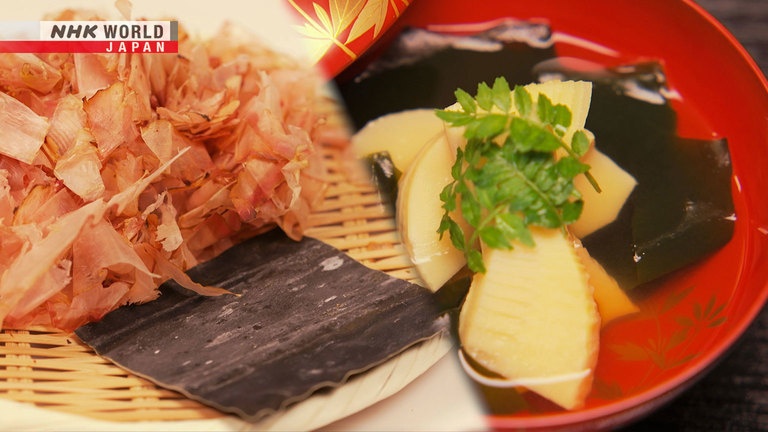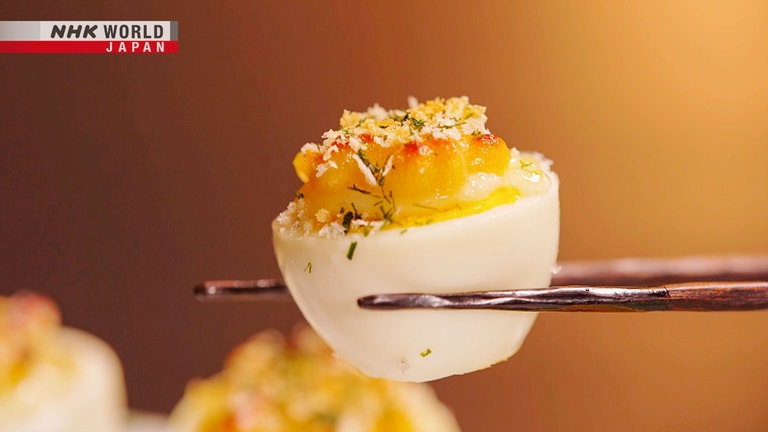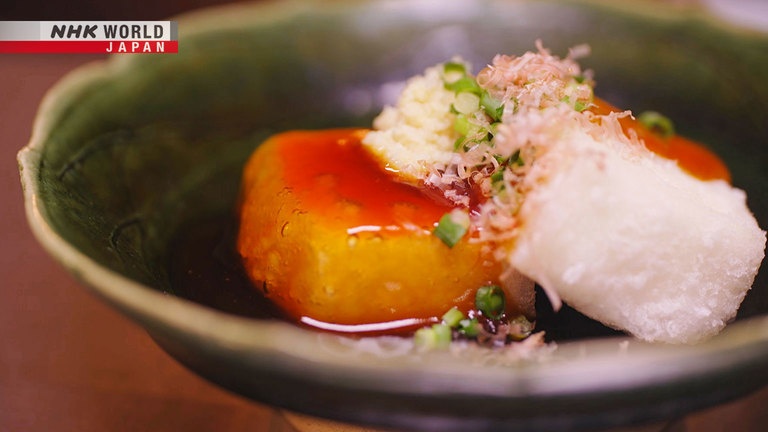Authentic Japanese Cooking: Kaiseki Cuisine - A Dining Experience in Old Tokyo
Let's visit a kaiseki restaurant in Asakusa, Tokyo. Chef Saito shows us how to enjoy a traditional kaiseki meal, and explains how to cook it yourself at home.
(1) Osuimono (Clear Dashi Soup)

Ingredients (Serves 2)
10 g kombu kelp
1000 ml water
30 ml water
15 g katsuobushi
Seasonal ingredient, as needed
Usukuchi soy sauce and salt, to taste
Fragrant garnish, as needed
Directions
1. To make the dashi stock, simmer the kombu over medium heat for 10 minutes. Add some water and katsuobushi. Maintain a gentle boil for about 20 or 30 seconds. Strain the dashi.
2. Season with usukuchi soy sauce and salt.
3. Add a main seasonal ingredient. Arrange the ingredients in a bowl, cover with soup and top with a fragrant garnish.
(2) Miso-mayo Baked Eggs

Ingredients (Serves 2)
5-6 eggs
White miso, as needed
Mayonnaise, as needed
Panko, aonori and salt, as needed
Directions
1. Make the hard-boiled eggs.
2. Cut both ends of the hard-boiled eggs. Use a thread to cut the eggs in half. Place the eggs on a baking plate with a baking sheet.
3. Place the white miso in a plastic bag. Roll it up into a cone, cut off the tip of the bag and squeeze the miso onto the eggs and sprinkle with panko and salt.
4. Bake in an oven or toaster for 7 to 8 minutes until the panko is golden brown.
5. Top with aonori and serve.
(3) Agedashidofu (Deep-fried Tofu with Seasoned Dashi)

Ingredients (Serves 2)
350 g silken tofu
5 g green onions
30 g grated ginger
Fine katsuobushi, as needed
Potato starch, as needed
For the Bekko-an sauce:
200 ml dashi
50 ml mirin
50 ml soy sauce
Potato starch slurry (1 1/2 tbsp each of potato starch and water)
Directions
1. Cut the tofu into 3cm cubes. Place between paper towels and set aside for half an hour.
2. Coat evenly with potato starch and fry immediately in oil heated to 170 degrees Celsius for 3 to 4 minutes.
3. For the Bekko-an sauce, add the dashi, mirin and soy sauce to the pot and place over medium heat. Bring to a boil, add the slurry a little at a time while mixing.
4. Pour the sauce over the tofu and top with grated ginger, sliced green onions and katsuobushi.
Transcript
Dining with the Chef!
Have you ever heard of "kaiseki" cuisine?
It embodies the essence of Japanese food culture.
The colorful and breathtaking beauty of each dish is a work of art,
reflecting the chef's sophisticated technique and consideration for diners.
"Kaiseki" cuisine is for special occasions with special people.
It's the ultimate in Japanese hospitality.
Today, Chef Saito and Yu have come to an old neighborhood in Tokyo
to treat themselves to an full course elegant meal at a traditional "kaiseki" restaurant.
Let's join them as they experience the wonderful world of "kaiseki" cuisine.
Japan is known for its bountiful fresh and delicious ingredients.
Amazing!
Japanese cuisine, guided by traditional culture that you will be able to prepare at home.
Perfect.
Today, an insight into what makes dining at a traditional "kaiseki" restaurant a truly memorable experience.
Let's join Yu Hayami and become Chef Saito's chef apprentices.
Here is our Master Chef, Mr. Tatsuo Saito!
It's always a fun time with the chef.
Authentic Japanese cooking.
Now for the best of "kaiseki" cuisine.
This is Asakusa, Tokyo.
Sensoji is the oldest temple in Tokyo, founded over 1,000 years ago.
It's in the center of Asakusa, a popular tourist destination which still retains much of the traditions and culture of the past.
The landmark temple gate, is the symbol of Asakusa.
Our destination is just a four-minute walk away.
A traditional restaurant that has been in business in this area for over 60 years.
For three generations, it has been providing guests, from far and wide with the best of Japanese cuisine and hospitality.
The building, a stunning example of contemporary Japanese architecture, was designated a tangible cultural property in 2021.
It's so peaceful. It doesn't
feel like Asakusa.
No.
What a beautiful garden.
When stepping into the tranquil Japanese garden, it's like entering a different world.
The "kaiseki" culinary experience actually starts when entering the garden.
- Here comes the "okami," the owner.
- Hello.
- Hello.
- Welcome.
Thank you.
This is such a beautiful garden with so much history.
Such a beautiful garden and building!
It's like entering a different world.
Thank you.
Chef Saito, this is so exciting to dine at such a beautiful classical "ryotei" restaurant.
Yes. Not only eating, but also feeling. Everything is very important in "kaiseki."
Chef Saito explains how to make the most of the "kaiseki" experience.
"Kaiseki" course is all about season.
Every aspect of "kaiseki"
is focused on the season.
Japan has different climates and distinct seasonal changes.
The cherry blossoms of spring make way for the hot summer,
followed by dazzling autumn colors, and finally a flurry of snow in winter.
The seasonal changes are reflected in culinary ingredients.
The tableware, interior, the garden.
Food is only part of the experience.
All the elements come together
like a jigsaw puzzle.
Communication with Host.
It's not an everyday experience,
so it's only natural to feel nervous.
If you're uncertain about the protocol
just ask the manager and staff.
They're happy to answer any questions
in the spirit of hospitality.
Here comes the first course.
A selection of appetizers.
The bamboo tube holds persimmon
in pureed tofu.
Persimmons with a tofu dressing: an autumn fruit dressed with tofu paste with sesame, sugar and other seasonings.
The hollowed-out "kabosu"
contains chrysanthemum.
Seasonal vegetables in a "kabosu" basket: Greens and chrysanthemum flowers are simmered in "dashi,"
and plated in a hollowed-out "kabosu," a fragrant citrus fruit.
A savory omelette cake.
The black food is "sumi gobo,"
literally charcoal burdock root.
It's been simmered in a cast-iron pot
for a week.
The bitterness of the "gobo" reacts
with air and iron to turn black.
It's tender and is rich in anti-oxidants.
Chef, this is our first dish, but it's so beautiful.
- So beautiful.
- What a wonderful way to start a course meal.
Yeah. First dish is very important.
It has to convey the season and
provide a variety of flavors.
Cheers.
This is such a beautiful glass as well.
So in this case, I always start with...
I recommend starting
with the white one.
Kinutamaki: Crab meat, wrapped in thinly sliced vinegared "daikon" radish.
So I will try this "daikon" with...
Mmm.
- Very refreshing.
- Refreshing.
I really want to try this "kabosu" with chrysanthemum flowers.
And look how beautiful.
The color is so pretty.
This assortment of appetizers
reflects the chef's sensibilities.
So much thought goes into the selection
and preparation of ingredients.
I think it's just beautiful. It's an art.
And like art, it's fascinating
to study the details.
Understanding the artist's techniques
enhances your appreciation.
- You said art. Same thing.
- Yes.
So the more you know about "kaiseki ryouri," the more you'll be able to enjoy the food as well as the atmosphere.
So let's take a moment to review Chef Saito's "kaiseki" lesson.
"Kaiseki" cuisine, consists of 8 or more courses served in a set order,
from starters and side dishes, to main dishes, and finally rice and dessert.
The first course is the "sakizuke" or appetizer,
an artistic presentation of seasonal delicacies to whet the appetite and heighten expectations.
This is followed by a hot soup.
So, next course is soup.
Let's open it and see what's inside.
Oh, it's so beautiful.
This is wonderful.
First, sip the soup.
Hold the bowl with both hands.
Savor the aroma.
So nice.
- Okay.
- Yes.
And this soup.
And then we have this soup.
How would you feel?
There's not a strong taste of any one ingredient.
I feel like it harmonizes very well with, there's fragrance of the "matsutake" and of course, the fish.
The "hamo" gives it a very deep flavor as well.
There are three components to "osuimono."
The "wandane," or main ingredient,
is the "hamo" fish.
The "wanzuma," or complementary
ingredient, is the "matsutake."
And the "suikuchi," or fragrant
garnish, is the "yuzu."
Bring the "yuzu" to the rim of the bowl
and sip the soup.
Enjoy the aroma to the full.
Really?
Oh that's true.
This also brings out the richness
of the "hamo."
Can you tell us a little bit about how it was prepared?
We emphasize the flavor of "kombu."
We used a variety called "ma-kombu,"
soaked for more than half a day.
It's then simmered below 70℃ for
an hour and set aside to cool.
So it takes 2 days just for the "kombu."
And for soup, we use "magurobushi"
instead of "katsuobushi."
Tuna shavings are more expensive than the typical "katsuobushi" made from skipjack,
so they're used exclusively in restaurants to add a distinctive flavor to soups.
She mentioned the emphasis
on "kombu dashi."
It's the restaurant's trademark.
One of the pleasures of "kaiseki" cuisine
is in experiencing something different.
So I recommend having a chat
with the owner.
Chef Saito shows us how to make a quick and easy "dashi" at home.
All you need is some "kombu" and "katsuobushi."
When buying "kombu," look for sheets
with lots of white powder.
This is an umami ingredient called
mannitol, so don't remove it.
But you may need to gently wipe off
bits of grit.
Add the "kombu" to a pot of water and place over medium heat.
Bring to a gentle boil.
The "kombu" is enjoying a relaxing bath.
It's slowly releasing its umami.
If you touch it now, it'll become tense,
and the umami will be trapped inside.
Gently boil for 10 minutes.
After 10 minutes, remove the "kombu" and add water to stop it from boiling.
Add the "katsuobushi" and gently boil for 20 to 30 seconds.
The "dashi" is bursting with umami flavor from the "kombu" and "katsuobushi."
After 30 seconds, turn off the heat and filter through a strainer, lined with paper towels.
Squeeze out every single drop.
Finally, season the "dashi" with "usukuchi" soy sauce and salt.
Add a little at time, and try after each addition, until you get the taste you want.
Then add a main seasonal ingredient, a complementary ingredient, and a fragrant garnish
and you'll have a soup that rivals that of a "kaiseki" restaurant.
The next course is the "otsukuri" or sashimi.
Fresh fish is cut to perfection using a sharp knife so that the cross section is clean and smooth.
The way the sashimi is sliced and presented along with the seasonal garnishes, reflect the chef's technique and sensibilities.
After the cool sashimi, comes a hot dish.
The overall flow of the meal is very important in "kaiseki."
Chef Saito and Yu are served a savory custard with mushrooms, perfect for autumn.
Now for the main course, "yakimono" or a grilled dish, which in Japan is usually fish.
Today, the restaurant is serving white miso marinated grilled fish.
Chef Saito has come up with a "yakimono" that you can make at home.
Miso-baked eggs!
Hard boiled eggs with miso, mayonaise filling.
Before boiling, tap the rounded end of the egg with a spoon, to form a hairline crack.
This will make it easier to peel later.
Put the eggs in a pot of water and place over medium heat.
Bring to a boil and then reduce the heat to low.
Cook for 12 to 13 minutes, so that the yolks are set as well.
Then peel the shells off the eggs and cut off the ends.
Then wrap a thread around the middle of the egg and pull to cut smoothly in half.
A knife will make a mess.
Such a nice smooth cut.
Place the eggs on a baking sheet, lined with aluminum foil and squeeze miso and mayonnaise on top.
Sprinkle with "panko" and salt and bake in a toaster oven.
Bake at 200 degrees Celsius for 7 to 8 minutes until the "panko" is golden brown.
7 minutes later...
Okay, let's check.
Oh that looks so delicious! What a wonderful dish.
Finally, sprinkle with dried "aonori" and the fragrant miso baked eggs are done.
The next dish is "Nimono," something simmered, seasonal ingredients, mainly vegetables, simmered in a savory "dashi."
The "nimono" in "kaiseki" are prepared with far more care than a standard "nimono" dish.
Next, "Agemono," a deep-fried dish.
Tilefish, which is in season from autumn to winter,
is deep-fried to crisp the scales and make them stand up to look like a "matsukasa," or a pinecone.
- This is the last plate of the main dishes.
- Yes.
Tilefish is in season now.
The skin is firm and tasty.
Deep-frying produces
two different textures.
Crispy on the outside, juicy inside.
It's a technique used only for tilefish.
Oh, this is so beautiful.
You can tell it's autumn by the gingko nuts, by the rice grain that's popped.
And the pine leaves from the pine tree.
The deep-fried ears of rice evoke
the arrival of the autumn.
It's the rice harvest season.
The dish in the restaurant is rather tricky, so instead, let's try making a much simpler kaiseki-style deep-fried dish.
"Agedashidofu," deep fried tofu.
Cut the silken tofu into 3 centimeter cubes.
And wrap in paper towels to absorb the excess moisture.
Coat the tofu evenly with potato starch and deep fry at 170 degrees Celsius for 3 to 4 minutes.
Overcooking ruins the umami flavor, too
Also, you don't want to brown the tofu.
It won't look as elegant.
Remove once the surface is crisp.
Now for the sauce.
Add "dashi," "mirin," and soy sauce to a pot and place over low heat.
Once it starts to bubble, add potato starch mixed with water in small increments and mix well.
Be careful not to burn the soy sauce.
Keep on mixing to prevent lumps from forming.
Pour liberally over the fried tofu, and garnish with grated ginger,
chopped scallions, and "katsuobushi" to complete the dish.
And it's done!
Okay, Yu-chan.
So important. Final. It's coming.
The final touch of hospitality.
- Wonderful.
- It's very important.
Next, a rice dish to wrap up the meal.
Freshly harvest rice cooked in a pot.
Autumn in Japan is rice harvesting season.
The flavor of freshly harvested rice is really something else.
Rice is an integral part
of Japanese culture.
Serving rice from a clay pot at the table
is the ultimate in hospitality.
The rice was cooked just for us.
That's wonderful.
There's a natural sweetness with each bite.
- Just crunchy?
- And it's crunchy.
While savoring the rice, we're reminded
that the year is coming to an end.
I see. And if we want seconds, can we ask for more?
Yes. It's actually more polite.
It shows your appreciation.
"Ikura" is the roe of salmon, it's in season in autumn.
The roe is marinated in a soy sauce mixture.
Wrap up your meal by eating your fill of rice and condiments.
These are the dishes that were served in today's "kaiseki" meal.
This plate of seasonal appetizers, is an edible work of art,
designed to heighten expectations for what is to come.
The hot soup, fragrant with seasonal herbs, warms the body and soul.
The assortment of sashimi may seem simple, but it demands, utmost skill to slice the fish properly.
Hot dishes are served after cool ones, to enhance the overall flow of the meal.
One of the main components of the main course is "yakimono," a grilled dish.
Usually, seasonal fish, prepared in various ways.
"Nimono" is a staple of home cooking.
But in "kaiseki," the foods are simmered and seasoned with the utmost care.
The last component of the main course, is a fried dish that's usually quite substantial.
"Tomezakana" refers to a vinegared dish or dressed salad, that refreshes the palate before the rice course.
The rice that marks the end of the meal is sometimes served fresh from the cooking pot at the table.
It takes about two hours to finish the multi-course meal, which is usually served in a private setting.
A "kaiseki" restaurant is committed to hospitality and will have started preparing for your visit, days before you even arrive.
So much thought and effort
has gone into each dish.
I've learned a lot today.
Thank you for providing us with
such a wonderful experience.
It was our pleasure.
It's important that our guests
enjoy the food.
Each dish reflects the changing
of the seasons.
We want guests to appreciate
Japanese culture.
So we love to hear guests say they enjoyed
both the food and the experience.
I think it's very important to know that a lot of preparation and time it takes in preparing a "kaiseki" meal.
Yes, please avoid cancelling
reservations on the day.
The finishing touch to a "kaiseki" meal, is the "mizugashi" or dessert which used to refer to fruit.
These days, traditional sweets are also served.
The end to a perfect meal!
"Kaiseki" cuisine is
for special occasions.
It's important to appreciate the
spirit of hospitality and tradition.
I'm a chef, but there's so much to learn
from eating as well as cooking.
Eating provides an insight
into Japanese tradition.
The choice of ingredients, the order
in which the dishes are served.
It's so exciting.
Your perspective changes
with the season.
I hope you and your friends will
enjoy these edible works of art.
So much thought and effort goes into
making this a memorable experience.
Enjoy the spirit of Japanese
hospitality to the full.
Nothing would make me happier than for
you to appreciate "kaiseki" cuisine.
You know, with the growing popularity of Japanese food around the world,
perhaps you can find a "kaiseki" restaurant near your home.
Thank you, everyone.
Thank you so much for watching Dining with the Chef.